The largest ever flying bird, Argentavis, was a giant predator, as big as a light aircraft. But how did such a giant take to the skies and stay there?
 Six million years ago, the skies of Argentina were home to fearsome predator – Argentavis magnificens, the largest bird to ever take to the air. It weighed in at 70kg and had a wingspan of 7m, about the same size as a Cessna 152 light aircraft.
Six million years ago, the skies of Argentina were home to fearsome predator – Argentavis magnificens, the largest bird to ever take to the air. It weighed in at 70kg and had a wingspan of 7m, about the same size as a Cessna 152 light aircraft.
Argentavis was a member of an extinct group of predatory birds understandably called the teratorns – ‘monster birds’. They are related to storks and New World vultures such as turkey vultures and condors. But Argentavis completely dwarfed even the massive Andean condor, weighing six times more and with a wingspan over twice as long (in the picture below, its silhouette is placed next to a bald eagle for scale).
There is no question that Argentavis flew. It has all the characteristics of modern flyers including light, hollow bones and strong, sturdy wings. It’s how it flew that palaeontologists have puzzled over, given its massive size in relation to modern birds.
Take-off
For a start, how did it get its large bulk off the ground in the first place? The heaviest living flier, the Great Kori Bustard, is over three times lighter than Argentavis, and even it can only take off after arduously ‘taxiing’ like a airplane.
Sankar Chatterjee from the Museum of Texas Tech University decided to model the giant’s flying style by running simulations with known fossils. He found that Argentavis simply couldn’t have generated enough lift from a running-take-off.
It needed height to get airborne, but it could manage with surprisingly little. Even a gentle down-slope of 10° and a light headwind would have given it enough extra power to avoid an embarrassing crash. Albatrosses and hang-glider pilots use the same technique today.
In the air
 Once in the air, the flapping flight that small birds use was out of the question for the giant predator. By studying its skeleton, Chatterjee estimated the maximum amount of power that its flight muscles could have generated. And while substantial, it was still 3.5 times less than the minimum amount of power needed to fly.
Once in the air, the flapping flight that small birds use was out of the question for the giant predator. By studying its skeleton, Chatterjee estimated the maximum amount of power that its flight muscles could have generated. And while substantial, it was still 3.5 times less than the minimum amount of power needed to fly.
Instead, Chatterjee believes that Argentavis was a master glider. It was capable of soaring for great distances at a shallow angle of 3°, continually re-shaping its wings to control its glide.
Unlike flapping, the efficiency of gliding doesn’t change very much with size, if a bird sticks to the standard body plan. So despite its enormity, Argentavis sailed through the air with as much grace as much smaller species like the buzzard or white stork.
Like modern soarers, Chatterjee believes that Argentavis used two techniques. By flying along the Andean ridges, it stayed aloft using upwards air currents produced by wind deflected up the cliffs. The several fossils found at the Andean foothills support his idea.
Because of its efficient gliding, it could stay aloft using relatively slow drafts of wind. Chatterjee calculated its top speed at about 70 km/h, allowing it scan vast tracts of land for prey. It’s a very energy-efficient style and today, eagles and vultures use it to great effect, sometimes covering hundreds of miles without a single wing flap.
Hot air
When the bird switched from the mountains to the wide, open spaces of the pampas, it switched to a different method – thermal soaring, where rising columns of hot air provided it with lift.
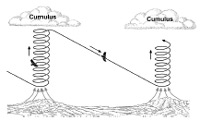 Popcorn-like cumulus clouds betray the location of thermals, and by circling around one, Argentavis could have risen through the air, giving itself enough height to soar to the next thermal. Despite its large size, Chatterjee calculated that Argentavis was manoeuvrable enough to manage the tight circular turns needed to stay within a thermal column.
Popcorn-like cumulus clouds betray the location of thermals, and by circling around one, Argentavis could have risen through the air, giving itself enough height to soar to the next thermal. Despite its large size, Chatterjee calculated that Argentavis was manoeuvrable enough to manage the tight circular turns needed to stay within a thermal column.
Even with this reliance of thermals, Argentavis was pushing the limits of even gliding flight. Any heavier and it would have exceeded the maximum weight for safe gliding. So why are there no equally sized giants today?
Chatterjee thinks that the late Miocene’s climate provided the answer. Six million years ago, Argentina was much hotter and drier than it is today – just the weather needed for generating the powerful thermals needed to lift such a large bird.
Argentavis was beautifully adapted to take advantage of this large, open habitat, where it could travel across large distances in search of prey. And unlike modern condors, it was no mere scavengers. Its skull was as long as my forearm and ended in a formidable hooked beak – it was an active hunter, possibly taking prey on the wing. .
Reference: Chatterjee, Templin & Campbell. The aerodynamics of Argentavis, the world’s largest flying bird from the Miocene of Argentina. PNAS doi.10.1073/pnas.0702040104.
Images from PNAS paper and Apokryltaros
Related posts on extinct animals:
Bone-crushing super-wolf went extinct during last Ice Age
Microraptor – the dinosaur that flew like a biplane
How many types of dinosaur were there?
Tracks provide evidence of swimming dinosaurs
Filed under: Animal behaviour, Animal kingdom, Animal movement, Birds, Palaeontology, Predators and prey | 10 Comments »
![]() The nasal screech of Chris Tucker sound worlds apart from the song of a nightingale but both human speech and birdsong actually have a lot in common. Both infants and chicks learn their respective tongues by imitating others. They pick up new material most easily during specific periods of time as they grow up, they need practice to improve and they pick up local dialects. And as infants unite words to form sentences, so do songbirds learn to combine separate riffs into a full song.
The nasal screech of Chris Tucker sound worlds apart from the song of a nightingale but both human speech and birdsong actually have a lot in common. Both infants and chicks learn their respective tongues by imitating others. They pick up new material most easily during specific periods of time as they grow up, they need practice to improve and they pick up local dialects. And as infants unite words to form sentences, so do songbirds learn to combine separate riffs into a full song. 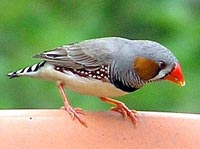







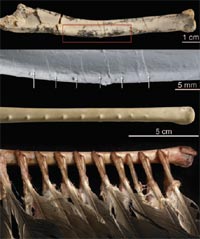
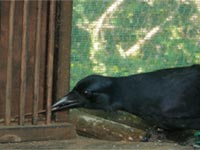
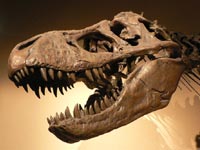







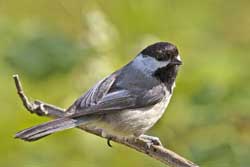 When this call sounds out, anywhere between 24 and 50 species of bird marshall together and mob the predator, robbing it of the element of surprise and harassing it from the area.
When this call sounds out, anywhere between 24 and 50 species of bird marshall together and mob the predator, robbing it of the element of surprise and harassing it from the area. They recorded two variants of the chick-a-dee call, by exposing the birds to two species of owl, one large and one small, in controlled encounters. They then played the calls back to red-breasted nuthatches – common flock-mates of chickadees – from a speaker hidden in a tree. As predicted, the nuthatches mobbed the speaker in response to both calls.
They recorded two variants of the chick-a-dee call, by exposing the birds to two species of owl, one large and one small, in controlled encounters. They then played the calls back to red-breasted nuthatches – common flock-mates of chickadees – from a speaker hidden in a tree. As predicted, the nuthatches mobbed the speaker in response to both calls.




